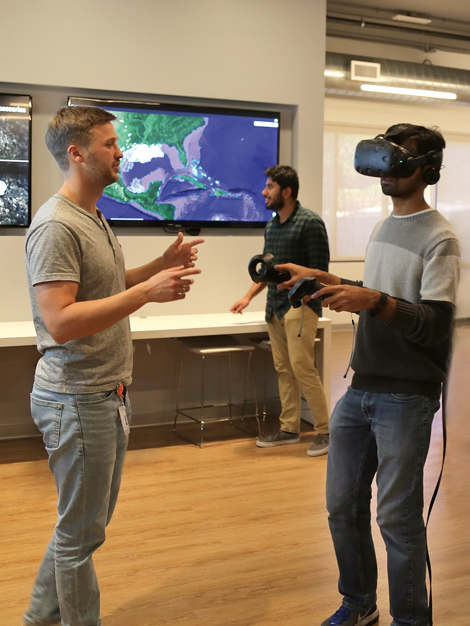
Subsurface expert Sergey Doronichev (left) and Data Scientist Vishakh Hegde explore the capabilities of virtual reality for the visualization of 3D seismic surveys at the Schlumberger Software Technology Innovation Center in Menlo Park, California.
Schlumberger Software Technology Innovation Center (STIC) was established in 2014 with a goal of leading the oilfield digital transformation by taking advantage of technology trends driven by Silicon Valley companies. The center team consists of a highly technical workforce, including Schlumberger experts and recent university graduates. The technical staff includes cloud and big data engineers, user experience (UX) designers, front-end web developers, data scientists, and machine learning experts.
The primary focus of STIC is to deliver technology proof points—working code that leverages new technology applied to oilfield challenges. The center regularly aligns its priorities with stakeholders from the Schlumberger product lines. STIC is closely connected with the Schlumberger software community, hosting hackathons and design sprints to bring engineers, stakeholders, and end users together to accelerate the software-development process.
The center maintains affiliations with earth science, computer science, and computational mathematics departments of Bay Area universities, most notably Stanford. It also partners with companies in Silicon Valley to gain knowledge about how digital technology and infrastructure are applied in other industries. STIC has become a focal point for Schlumberger to communicate its digital vision with customers, with the center frequently hosting meetings and workshops that provide in-depth technical engagement.
Over the past three years, STIC has worked with and evaluated more than 400 companies and pursued projects with over 70 of them. By working together with partners, we continuously learn about new capabilities and opportunities while integrating with the Silicon Valley ecosystem. Through close collaboration with these digital technology partners, Schlumberger is able to develop digital technology solutions in less time, thus reducing the development lead time. This is our new way of working for technology development.

The three stations shown of the Manara production and reservoir management system control the production characteristics of an individual zone. Produced fluids, noted with green for oil and blue for water, flow through a screen to the station where pressure, temperature, flow rate, and water cut are measured.
Saudi Aramco had a vision and commitment to develop technology that would take hydrocarbon recovery to a new level. Named after the Arabic word for lighthouse, the Manara system is the result of an eight-year collaboration between Saudi Aramco and Schlumberger.
The Manara production and reservoir management system is an intelligent completion system for multizone, multilateral, extended-reach, and Extreme Reservoir Contact wells. Combining 30 patented technologies, the Manara system provides permanent downhole pressure, temperature, water cut, and flow rate monitoring as well as in-lateral flow control of zones in real time.
The information derived from a conventional completion system typically permits engineers to make production decisions in days or weeks. The Manara system’s real-time permanent monitoring reduces the decision-making time to hours. This means reservoir workflows that commonly required three to six months can now be performed in one day. Integrated workflows from multiple disciplines create a collaborative work environment, where the identification and correction of problems in individual zones are made in real time. Rig time is reduced by optimizing a zone-by-zone cleanup procedure that also minimizes health, safety, and environmental risks.
The Manara system uses fewer parts than a conventional completion system. Electric power and downhole data pass through an inductive coupler that can service any number of well junctions. One electric control line connects through the wellbore to the wellhead via a single penetration.
Saudi Aramco’s Dhahran Advanced Research Center coordinated user requirements and, in conjunction with Schlumberger Engineering, developed a qualification testing program to de-risk the enabling technologies in the Manara system. This included extensive field testing in multiple Saudi Aramco wells. The Schlumberger focus on the transformation themes of technology, reliability, efficiency, and integration was important for the successful collaboration with Saudi Aramco.